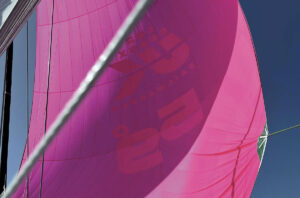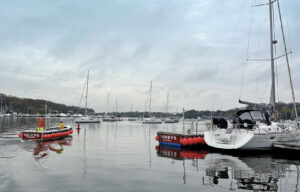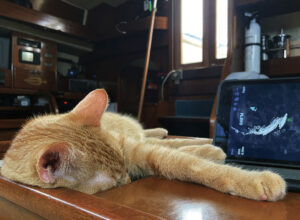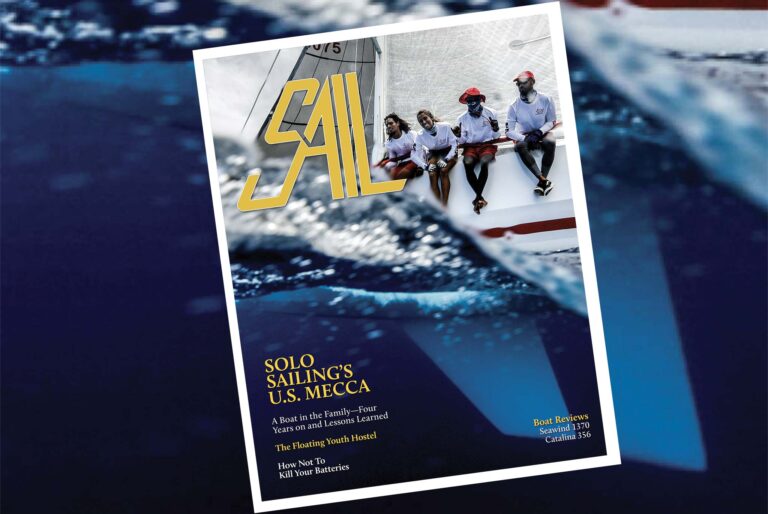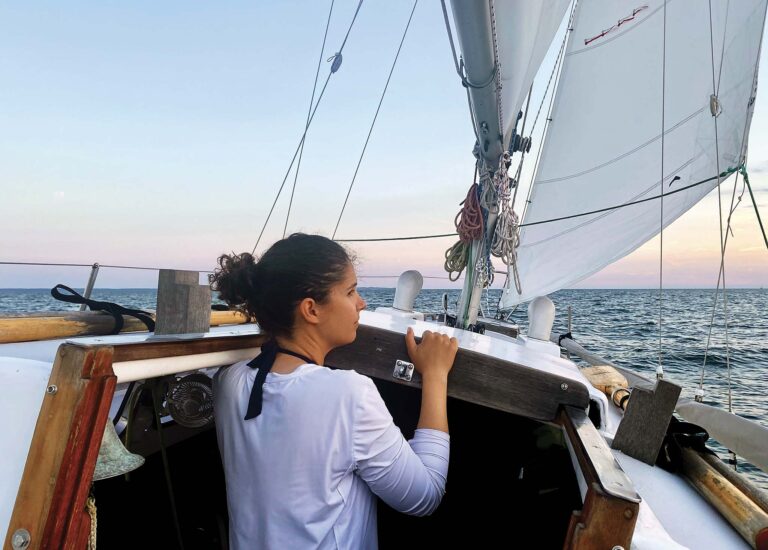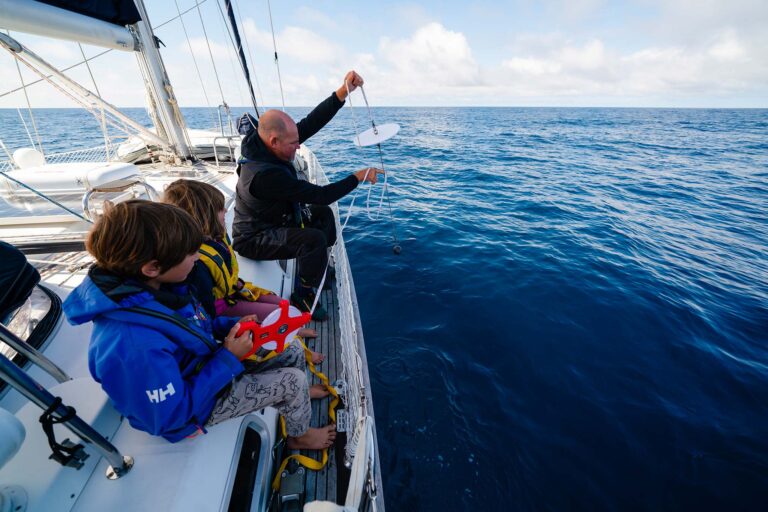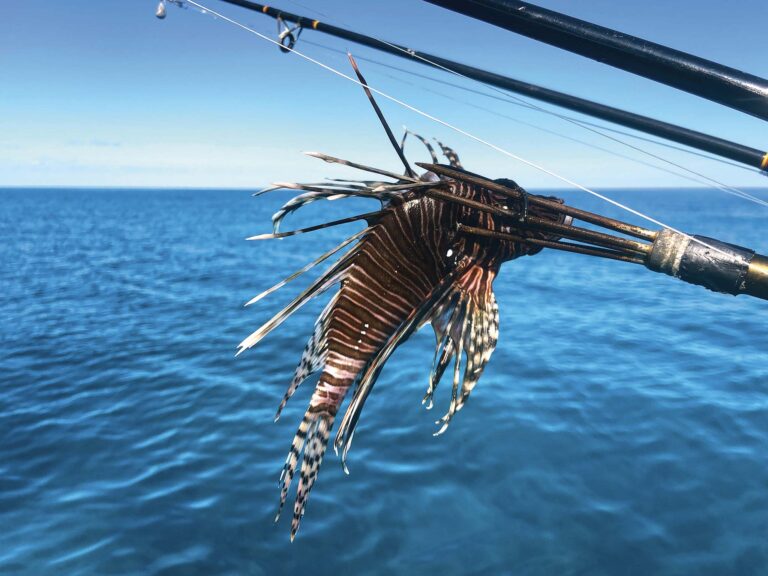You’ve probably already seen some pretty amazing birds while sailing. How about the dramatic plunge-dives of Northern Gannets? Or the beauty of elegant, long-tailed Roseate Terns fishing in your wake? Have you enjoyed the company of the “swallows of the sea” (Wilson’s Storm-Petrels) as they pitter-patter over the ocean’s surface feeding? If these raise a memory and bring a smile to your face, you’re already a sailing birdwatcher!
There’s so much to enjoy about birds while afloat. And you’re in an enviable position. Many of these species are never seen by avid land-birders, as many pelagic birds spend their entire lives at sea, only coming ashore briefly to breed on remote islands.
And as a sailor, if you’re passionate about the sea and environment, you should consider joining citizen-science efforts and contributing to seabird conservation by taking photographs and reporting your sightings to projects such as the “SeaBC” (Sea Bird Count).
But these birds aren’t perching prettily, waiting to be photographed at your backyard feeder! It’s a different world when you’re on a moving boat and the subject is darting way off on the gray horizon.
Eyes on the Water
The ocean’s surface may seem uniform from a sailboat, but it’s not. Expect to see patches of birds, then hours of nothing. As offshore fishermen know, fish (and bird) activity signals food availability, which is influenced by sea-floor topography and currents.
Many premier sailing destinations are also notable for their bird life. On the East Coast, this includes the Maine coast, the Stellwagen Bank off Massachusetts, and the Florida Keys. On the West Coast, sailors with a yen for wildlife spotting will be familiar with California’s Channel Islands and Monterey Bay, and the San Juan and Gulf Islands in Washington State and British Columbia. Of course, the Caribbean is always a bonanza, with its tropicbirds, frigate birds and boobies.
The best seabird spotting is in early morning or in the evening, when birds tend to be more active. For this reason, Dorothy Wadlow, an experienced birder and transatlantic sailor, always volunteers for the dawn watch, when she’s likely to see the most birds.
Birding on the water is something you can do all year. Because most birds migrate, their ranges vary over the seasons. Even if you sail the same coastal triangle each weekend, you’re likely to notice the bird demographics shifting with each passing month. One of the best ways to start as an onboard birder is to learn the regular species of your local cruising ground. Reports of these repeated observations (to ebird.org, for example) have the greatest conservation value.
Just as avid sailors are often out on the water when it’s blowin’ stink, so are the birds. Long-distance pelagic birds, such as albatrosses, petrels and shearwaters, depend on strong winds for their energy-conserving dynamic flight techniques, where they ride air currents created by the wind and waves.
Similarly, during fall and spring migrations, don’t be surprised if a tiny, feathered hitchhiker lands on your boat. These migrants fly hundreds of miles over open water and, like you, sometimes need a rest. Typically insect-eaters, they won’t eat seed, so just let them rest and provide them with some fresh water. They will continue their journey when they’re ready. Before your guest leaves, snap a photo and record your latitude and longitude to report your migrant’s rest stop.
Shoot First, Identify Later
With today’s technology and prices, there’s no excuse for not having a digital camera onboard. A photograph lets you share your sighting and get identification help, and provides scientists with a verifiable report.
For birding aboard, your camera should have: 1) zoom capability 2) vibration reduction, and 3) geo-tagging (automatic recording of time and location). You can adapt the gear you already own, or purchase a new portable, ultra-zoom camera for a few hundred dollars. For example, the Nikon Coolpix P600 is as small as a pocket-sized point-and-shoot camera, but its 60x optical zoom lens is the equivalent of a 1,440mm telephoto. The P600 retails for under $400, but unfortunately this model has dropped in-camera GPS for Wi-Fi. The comparable earlier models, such as the Nikon P520, are even more of a bargain and have in-camera GPS.
The best camera, of course, is the one that’s out and ready. You don’t actually find birds—or whales or sea turtles, for that matter—they find you. And they all seem to have the annoying habit of showing up at the most inopportune moments, so your camera needs to be accessible and ready at all times.
I’ve learned a few tricks that work well underway. First, when you bring your camera out for the start of the day, turn it on to let it acquire nearby GPS satellites. Then turn it off to conserve battery power. Keep the lens cover off and store it in a protected area of your cockpit, ideally on a scrap of non-skid shelf liner. You can also cover it with a hand towel (light-colored in the tropics) to protect it from sun, heat and moisture.
If something interesting flies or floats by, simply toss aside the towel, flip on the camera, auto-focus and shoot—a two-second process, with some practice. Always take multiple photos: in addition to increasing your chances of getting an attractive picture, it may take shots from several angles to make a confident identification. If your camera can shoot multiple images (often called continuous shutter) select this option. If your camera is not geo-tagged, no problem: snap a photo of your chartplotter showing the time/date stamp and GPS coordinates.
“SeaBC” Sea Bird Count
Presumably you keep a detailed ship’s log that includes meticulous records of your position, sea and weather conditions, and so on. If so, both the amateur birding and academic communities could use your sightings in a citizen science project for seabird conservation.
Marbled Murrelets confounded scientists for centuries who were unable to determine where they nested, in the trees of the old-growth forests of the Pacific Northwest
Photo courtesy of US Department of Agriculture
Bonaparte’s GullThis elegant little gull can be seen in the Great Lakes region when not breeding in Western Canada
Photo courtesy of Dick Daniels/carolinabirds.org
Black-Footed AlbatrossWho says you have to go to the Southern Ocean to see and albatross? The Black-footed Albatross is one of three species that ranges the Northern Pacific, including the U.S. Pacific coast
Photo courtesy of James Lloyd
Black Skimmer This intriguing species scoops up its prey with its oversized lower bill while flying just inches above the water’s surface
Photo courtesy of Dick Daniels/carolinabirds.org
Magnificent FrigatebirdAlso known as the “man-o-war” or “pirate bird,” because of its propensity for stealing meals from other seabirds on the fly, the Magnificent Frigatebird is supremely graceful soaring high overhead, but can’t swim
Photo courtesy of Andrew Turner
Arctic TernSmall and graceful, the Arctic Tern has the farthest yearly migration of any bird—traveling over 40,000 miles each year, round trip, between the Southern Ocean and Northern-Hemisphere breeding grounds
Photo courtesy of Andreas Trepte/photo-natur.de
The “SeaBC,” or Sea Bird Count, is a volunteer project organized by long-distance cruisers who are also interested in birds. It is also of great scientific value due to the that fact that seabirds are kind of the last frontier of bird conservation because their life habits remain poorly documented—a critical issue given that these often elusive birds, which spend most of their lives at sea, are currently under dire pressure from pollution, fishing and climate change. Of the 22 species of albatrosses, for example, fully 19 are in danger of extinction. In other words, scientists and conservation groups need your help.
When you see a bird, take a photo and jot down anything you notice about it. Important data to jot down include the date and time of the sighting (this will match the photograph’s meta-data), field marks such as bill or feet color, size and shape (or make a sketch), the number of birds, a description of its flight style, sea and weather conditions, any interesting behavior, and so on.
When you get to port and have hot-and-cold running Internet again, Sea Bird Count members can then help with or confirm your identifications using a network of expert volunteer reviewers. Once that is done, your sightings can be logged into eBird.org, a global database managed by Cornell University’s Lab of Ornithology.
The community site for the SeaBC program, Birding Aboard, is another great resource. Information is available on their Facebook page, where you can share your questions, photographs and experiences with other birders. The Birding Aboard web site (birdingaboard.org) also has resources for kids aboard, recommended camera models, additional field guides, SeaBC tally sheets and more.
Bottom line: seabirds are not only magnificent animals more then worthy of study in and of themselves, they need you. As you sail through these under-surveyed areas, you’re in a unique position to make a contribution. Your sailboat is what scientists call a “ship of opportunity.” You are valuable eyes on the water, able to report seabirds that are not sighted by others. So let’s focus those binoculars on seabirds!
Featherweight Field Guides
Identifying seabirds can be tough. You are, after all, trying to pick out field marks on a fast-moving bird from a moving boat without any kind of a size reference, often against the sun’s glare. Worse yet, even if you get a good look, most seabirds are frustratingly similar in appearance, with subtle combinations of white below and gray above, countershaded for the sky and ocean. Field guides, typically massive tomes showing myriad plumages, aren’t much help. Sometimes even experts can’t agree on a sighting.
With this in mind, don’t worry so much early on about identifying individual species. Instead, start out by familiarizing yourself with the various different seabird families. Experience the excitement of identifying a frigate bird overhead or a storm petrel tiptoeing in your wake—or a jaeger attacking a gull. Don’t worry if it’s a “Pomarine Jaeger” or a “Parasitic Jaeger.” (For a downloadable seabird primer sheet that can be laminated for use in the cockpit, visit birdingaboard.org/resources.)
If you have a smartphone, a field guide app is a must. I recommend iBird or Waite’s Guide to Birds of America (ibird.com). Other good choices include The Sibley eGuide to Birds (sibleyguides.com), or Peterson Birds (petersonguides.com). The great thing about digital field guides is that they don’t add weight, take up space, or absorb moisture or mildew. On the downside, field-guide apps are hard to flip through, so be sure to take advantage of their “smart search” features, which allow you to provide clues (such as location, size, color, and so on) for suggested matches.
For example, when sailing from Block Island to Chesapeake Bay in October, you might see “a large, long-winged shearwater-type bird, very white underneath, with a dark cap.” Entering some of these search constraints (New Jersey, October, ocean habitat, large bird) into iBird’s Search tool yields only 13 matched species, allowing for a quick visual match with Great Shearwater.
If you don’t own a smartphone, consider adding Tove’s Guide to the Offshore Wildlife of the Northern Atlantic or The Sibley Field Guide to Birds of Western North America to your ship’s library. Both are compact paper guides, the former covering the Caribbean to Newfoundland to the U.K. and the latter for Pacific Coast sailors.
Diana Doyle and her husband, Mark, live aboard and cruise the Atlantic Coast. Diana is a department editor for the American Birding Association’s Birding magazine. She and Mark also manage the On the Water ChartGuides Foundation, which creates “almost free” cruising guides for the Intracoastal Waterway (onthewaterchartguides.org)

